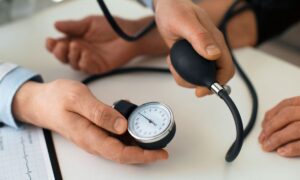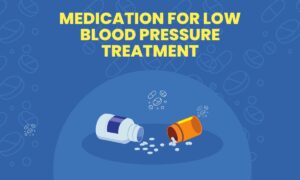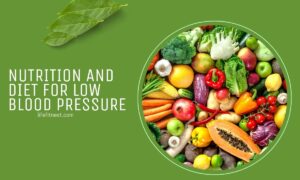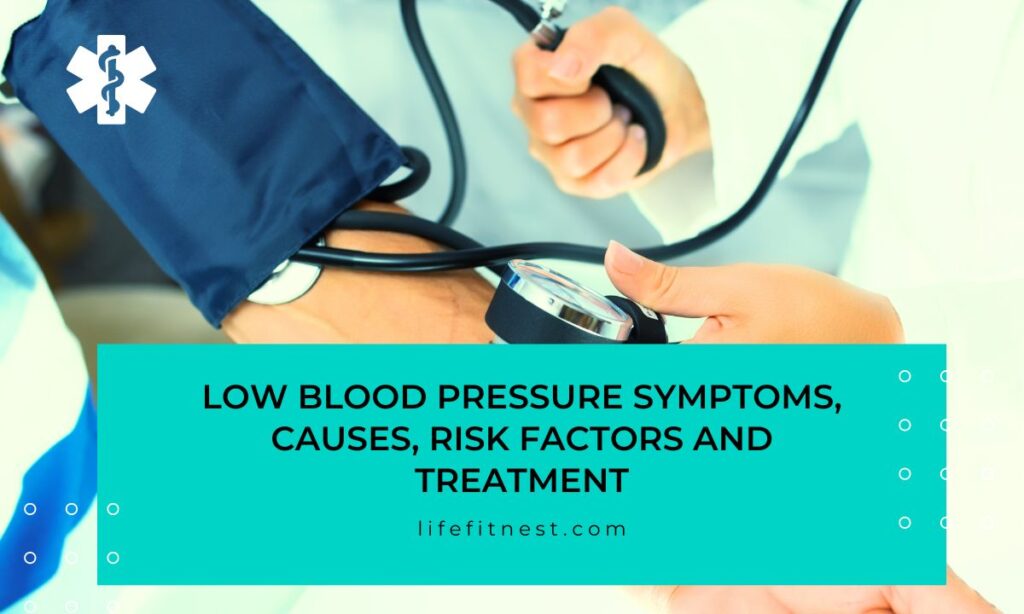What Is Low Blood Pressure/Hypotension
Hypotension, or low blood pressure, is defined as a systolic and diastolic pressure that is less than 90 and 60 millimeters of mercury (mm Hg). Normal blood pressure is slightly less than 120/80 mm Hg, and blood pressure is typically measured in millimeters of mercury.
Low blood pressure is not always dangerous, but persistent hypotension can result in a lack of blood supply to the brain, which can lead to lightheadedness, unconsciousness, or blackouts. In extreme circumstances, it can even be fatal.
Low blood pressure is frequently a sign of other problems, like heart problems, plaque accumulation, or illnesses linked to aging. Early detection and attention to signs of low blood pressure are imperative.
Different Types of Low Blood Pressure
There are several primary categories of hypotension, and medical professionals may prescribe various low-blood pressure therapies for each type. Among them are:
Must Read :Ferritin Test: Importance, Procedure, and Results
This type of blood pressure drop is also known as orthostatic, and it is identified when there is an unusual drop in blood pressure upon abruptly standing up. When someone who has been lying down or seated gets up, their heart may not be able to change its rhythm to match their new position. This can lead to insufficient blood flow to the brain, which can cause symptoms of low blood pressure like lightheadedness or even unconsciousness.
The heart and endocrine system are impacted by the use of some drugs, both prescription and illicit, and by underlying medical conditions like liver or heart disease, which makes them incapable of quickly compensating for the blood’s downward movement when standing up.
Syncope Caused by Neurocardiogens
When the brain and heart do not receive the proper signals from the nervous system, blood vessels become unable to dilate or constrict to maintain blood pressure, which can lead to loss of consciousness, concussions, and other fainting episodes caused by an acute drop in blood pressure. It is also referred to as vaso-vagal syncope or neurally mediated hypotension.
After-Meal Hypotension
“Prandial” refers to eating, and eating a big meal can occasionally result in low blood pressure because it increases blood flow to the digestive system, which dilates blood vessels. Normally, the heart pumps more blood to keep blood pressure stable, but this is not the case in individuals who exhibit low blood pressure symptoms. Rather, they feel worn out and lightheaded.
Why Does Low Blood Pressure Occur
Along with body temperature, respiration rate, and pulse rate, blood pressure is one of the vital signs that are calculated to assess an individual’s health. As the heart beats, it purifies the blood and exchanges the gasses it contains, which creates pressure.
Blood is transported to and from the heart by a system of blood vessels throughout the body. Hypotension is the result of reduced blood volume pumped for particular reasons, which leaves the body with insufficient oxygen and nourishment. Even though hypotension can occur in many otherwise healthy individuals, the symptoms of low blood pressure are not always evident. Low blood pressure can occur for several medical reasons, including:
Being Pregnant
Because pregnancy causes the body’s circulatory system to expand and alter the production of certain hormones, fluctuations in blood pressure are normal. It is common to have low blood pressure at this time. Soon after delivery, it returns to normal, but if it causes more severe symptoms, medical attention might be necessary.
Heart Conditions
When the heart gets a signal from the brain, a can pump more blood to counteract any drop in blood pressure. Low blood pressure can result from heart attacks, heart valve problems, or arterial blockages in the heart that prevent the heart from pumping blood more consistently.
Unbalanced Hormones
In a healthy body, the endocrine system influences multiple signaling pathways, and an imbalance in its hormone production can result in a reduction in blood pressure. Low blood pressure is frequently linked to insulin and thyroid issues.
Anemia
The body produces fewer red blood cells when it lacks nutrients like vitamin B-12, iron, omega 2 and 3 fatty acids, and folate, which reduces the blood’s capacity to carry enough oxygen. A low-blood-pressure diet is frequently advised to treat symptoms and is very successful.
Kidney illness
The kidneys keep the proper ratio of water and nutrients in the blood to support blood flow. On the other hand, renal disease that causes either overhydration or dehydration can cause an electrolyte imbalance and blood vessel constriction, which will hinder blood flow.
Sepsis
A rare but well-known cause of low blood pressure is shock brought on by a serious infection that enters the bloodstream.
An Allergic Reaction
Low blood pressure symptoms can also be brought on by an extreme allergic reaction that impedes blood flow and causes the heart to beat irregularly.
Adverse Effects of Medication
Certain medications used to treat depression, hypertension, or heart problems can dilate blood vessels and cause abrupt drops in blood pressure. Only in certain situations, when a patient may have additional coexisting medical conditions, can the effects of low blood pressure become more noticeable. Most of the time, the decreased pressure is just a minor side effect of the drug and shouldn’t be too concerning.
Low Blood Pressure Symptoms
Many people do not experience symptoms of low blood pressure unless it is acute. Patients with persistently low blood pressure should consult a doctor if they encounter:
- Dizziness or lightheadedness
- emesis
- persistent exhaustion
- chilly, perspiring skin
- Heart palpitations
- shallow breathing that happens quickly
- Doubt or mental fog
- unconsciousness and concussion
- feeble heartbeat
Do You Face Danger?
Several factors, including advanced age, continuous medication, specific heart or neurological diseases, or medical procedures, can make some people more susceptible to low blood pressure. If home treatment for low blood pressure symptoms doesn’t stop the symptoms from happening, there could be a few reasons why:
Complications Associated with Aging
It is well known that as we age, our heart, neurological, and endocrine systems weaken. If this weakens the body’s vitality, low blood pressure can have several negative effects. If the person exhibits symptoms of Parkinson’s disease or has a history of liver, kidney, or heart problems, these need to be given more careful thought.
Drugs
Low blood pressure can result from prescriptions for medications that treat heart disease and hypertension, such as carvedilol, antidepressants, beta-blockers, or any combination of these. It is best to stay aware of any apparent symptoms of low blood pressure that could be a sign of chronic hypotension if you have been prescribed any such medication.
Underlying illnesses
The effective flow of blood throughout the body can be impacted by liver disease, renal dysfunction, heart disease, and neurological disorders or damage. It is best to search for pertinent symptoms if you suffer from any of these conditions.
Low Blood Pressure Diagnosis

A sphygmomanometer is a commonly used tool for determining low blood pressure. It involves placing an inflatable cuff around your forearm and having you sit with support. Since this cuff is worn at the level of the heart, it must be the proper size because a cuff that is too big or small will give an incorrect measurement.
The blood vessels constrict and relax in tandem with inflation and deflation. To detect the onset and duration of constricted blood flow, a physician uses a stethoscope placed near your elbow crook. Your blood pressure is defined as the measurement made at these two points in time.
A doctor may take multiple pulse readings in addition to taking your blood pressure because the pulse rate is a crucial sign of any abnormalities in the blood pressure. A fast, shallow pulse could be a sign that the heart isn’t beating fast enough to circulate enough blood throughout the body. Occasionally, a blood sugar test may be recommended to identify any signs or consequences of low blood pressure, or an ECG may be utilized to measure the heart rate precisely. To look for orthostatic hypotension, a “tilt-table test” that mimics a shift in posture while lying on a table might also be recommended.
The results of these tests determine the diagnosis, which is fairly straightforward. When deciding whether a person exhibits symptoms of low blood pressure or a more recent incident, their medical history is also taken into account.
Low Blood Pressure Treatment
Unless it is accompanied by other conditions, low blood pressure is typically easy to treat and requires little medication. Frequently, a low blood pressure diet may be advised, or a lifestyle change may be required. Typical suggestions consist of:
- Increased water intake: Proper hydration is essential, particularly in hot weather, during fevers, or diarrhea, as dehydration can lead to an electrolyte imbalance and low blood pressure symptoms.
- Increased sodium intake: foods high in sodium, such as cheeses, salted nuts, and cured meats and fish, can help stabilize blood pressure in cases where it is extremely low. But caution must be used to execute it correctly and preserve equilibrium.
- Reducing alcohol intake: Drinking alcohol can cause heart rate fluctuations. Cutting back on alcohol for a while can help people who are otherwise healthy but are experiencing symptoms of low blood pressure.
- Exercise: Moderate to strenuous physical activity helps maintain heart health and increase blood circulation. It is crucial to recognize the signs of low blood pressure, which include palpitations and chilly skin, to prevent aggravating the condition with exercise.
- Take care when changing your posture: When getting up from a sitting or lying position, postural hypotension can be reduced with mindfulness. Steadying the blood pressure by avoiding abrupt jerks gives the body time to recuperate from the blood pooling below because of gravity. It’s usually advised to turn to the side before getting out of bed, get up slowly, and sleep at an angle to raise blood pressure.
- Smaller, more frequent meals with fewer carbohydrates: Increasing meal frequency and number while reducing meal size is another low blood pressure diet tip. It helps reduce low blood pressure symptoms and stabilizes metabolism.
- Stopping any aggravating medications: Your doctor may suggest a different medication to take or perhaps advise you to stop taking the offending medication altogether until your blood pressure stabilizes.
Medication for Low Blood Pressure Treatment

Doctors may recommend medication to stabilize the blood pressure system in patients with more severe or recurring symptoms of low blood pressure. These could consist of:
- Fludrocortisone: When the body is unable to produce enough on its own, a steroid called fludrocortisone is prescribed. It is frequently prescribed in combination with other steroids, such as hydrocortisone. The body retains more sodium as a result of its reduction of inflammation. It might result in some water retention, but since blood pressure needs to rise, this is not a reason for alarm. While taking this medication, a doctor may advise consuming foods high in potassium, such as spinach, broccoli, bananas, and apricots, to keep the sodium-potassium balance. You might be instructed to stop taking the steroid while continuing to follow diet and lifestyle modifications once the effects of low blood pressure are no longer observed.
- Midodrine: A vasopressor that inhibits the dilation of blood vessels. To raise blood pressure, it narrows tiny blood vessels. It is typically prescribed to treat postural (orthostatic) hypotension, and to minimize side effects, the dosage is increased gradually over time.
Nutrition And Diet For Low Blood Pressure

One of the best ways to prevent hypotension is to eat a balanced meal that includes fish, lean meat, fruits, cooked vegetables, and complex carbohydrates. Preventing and treating postprandial fatigue and hypotension can also be achieved by altering meal patterns to be lighter and more frequent.
Patients are typically advised to follow a low blood pressure diet that maintains blood sugar levels while providing enough sodium and potassium upon diagnosis of a dip in blood pressure. It is advised to increase your intake of non-alcoholic beverages as this will help you stay dehydrated. Your doctor may advise you to make the easy adjustment of adding soy sauce or more salt to your regular cooking to counteract the effects of low blood pressure.
Engaging in Physical Activity to Lower Blood Pressure
Regular exercise can help to improve circulation and relieve any symptoms of low blood pressure, such as a 30-minute walk or light running. It is best to travel with a companion if you already suffer from hypotension in case you experience episodes of dizziness, fainting, or blurred vision during these times.
To smooth the flow of movement, heavy lifting, and other strenuous exercises must be avoided to spare the body from unnecessary strain and abrupt, jerky movements. Exercise routines that are consistent and disciplined support low blood pressure’s underlying causes while easing its symptoms.


![Understanding Leukemia: A Comprehensive Overview [2024]](https://newstechblog.com/wp-content/uploads/2024/08/cancerHealth-1-1024x536.png)
![Coughing up Phlegm: Causes, Symptoms, and Treatment [2024]](https://newstechblog.com/wp-content/uploads/2024/08/Coughing-up-Phlegm-Causes-Symptoms-and-Treatment-1024x614.jpg)